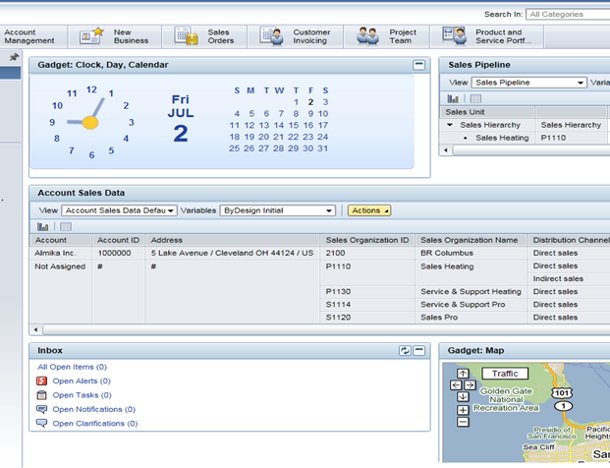Cheat Sheet: SAP Business ByDesign

The full lowdown on the business software giant's leap into software as a service
I didn't know SAP made technology for fashion designers...
Alas, Business ByDesign isn't in fact for fashion designers - it's a software-as-a-service ERP (enterprise resource planning) package. Aimed at mid-sized businesses, Business ByDesign has been in development for several years.
What does Business ByDesign actually do?
It's an ERP system encompassing applications for compliance, CRM, executive management support, finance, HR, project management, supplier relationship management and supply chain.
There are also different versions tailored to particular industries including automotive, consumer product, high tech, industrial machinery and components, mill products, professional services and wholesale distribution.

The homepage for Business ByDesign, which can be personalised to include the most important data for the user
(Photo credit: SAP)
So what's the big deal about it?
Well, SAP has traditionally made its money from on-premise software and Business ByDesign is its first attempt to make a significant play in software as a service.
So why does SAP need to go into software as a service?
Delivering software over the internet is becoming big business - global software-as-a-service revenue for enterprise apps is predicted to hit $8.5bn this year, up 14.1 per cent from 2009, according to analysts Gartner.
Offering enterprises potentially lower costs, greater flexibility and faster implementation times, software as a service is already becoming an increasingly important way for businesses to access their technology.
In order to keep up with its rivals, SAP needs to provide customers with software delivered over the net in addition to the traditional on-premise approach.
Just how important is it for the company's future?
The company has had a tough time recently with former CEO Leo Apotheker resigning in February this year and less-than-encouraging results for the 2009 financial year which saw revenues drop by eight per cent year-on-year.
Since they took the helm following Apotheker's departure, co-CEOs Jim Hagemann Snabe and Bill McDermott have...
...talked up the importance of Business ByDesign.
Speaking at this year's CeBIT tech trade show in Hannover, SAP co-CEO Jim Hagemann Snabe said Business ByDesign will be "a significant opportunity" for the company and its customers. "There is no doubt that companies like to consume software in an on-demand way," he added.
SAP's co-CEOs, Bill McDermott and Jim Hagemann Snabe
(Photo credit: Tim Ferguson/silicon.com)
So what's the history of Business ByDesign? How long has SAP been working on it?
Business ByDesign was first announced in September 2007 but in May 2008, SAP said it planned to reduce investment in the technology by €100m that year with no further "accelerated" investment planned for 2009.
When the investment cuts were announced, analysts said SAP was finding the development of the multi-tenant infrastructure needed to deliver the cloud-based technology a bigger challenge than it initially envisaged.
The company's limited experience with the medium-sized customers that Business ByDesign is primarily aimed at also hamstrung development of the technology, according to market watchers.
But with speculation that the end was nigh for the SaaS ERP project, the company confirmed that Business ByDesign remained an important part of its long term strategy.
"We're not pulling the plug on ByDesign as was suggested because it's a strategic piece of the portfolio and we're fully committed to it. Any rumours that say we're stopping it are just wrong," vice president of SME market development for SAP Business ByDesign, Mark Oakey, told silicon.com.
The original aim was to have 10,000 customers using Business ByDesign by 2010, generating $1bn in revenue, but the cuts in investment delayed the targets by 12 to 18 months. The technology only became fully available in July 2010.
So what was SAP doing to develop Business ByDesign all this time?
As well as developing the technology in its labs, SAP was also testing it with a group of customers in China, France, Germany, India, the UK and the US.
The company was still searching for Business ByDesign guinea pigs in September 2009 and ended up...
...with 100 customers that were using the technology prior to the full launch.
The first fruits of this development work were seen in July 2009 when the company released Business ByDesign Feature Pack 2.0, which included better integration of CRM tools with processes such as automated billing, project profitability, resource management and expense reimbursement.
What then?
A few months prior to full availability of Business ByDesign, SAP announced the features that would arrive with Feature Pack 2.5, including in-memory analytics, which allows users to analyse their business data faster. Support for mobile devices was also added - an area that SAP's recent acquisition of mobile tech company Sybase is likely to boost in the future.
The report gallery screen, shown above, is a way of accessing different sets of pre-defined data in Business ByDesign
(Photo credit: SAP)
A development environment in which third party resellers can add additional features and services to provide more industry-specific additions to Business ByDesign was also announced.
What if I just want to test the waters with Business ByDesign?
There are three starter packages if you want to give the technology a spin with versions for CRM, professional services and the core ERP and financial capabilities.
The starter versions mean customers don't have to commit to the whole product suite straight away and can add more functionality and applications to their package in a modular fashion should they choose.